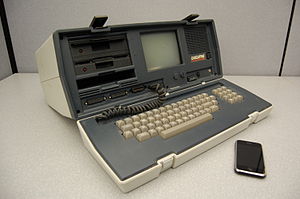- Osborne Executive
-
Osborne Executive 
Developer Adam Osborne Release date 1982 Introductory price USD$2,495 Discontinued 1983 *Bankruptcy Operating system CPM, CPM + CPU Zilog Z80 @ 4.0 MHz Memory 124KB The Osborne Executive was the planned successor of the already commercially successful Osborne 1 portable computer by Osborne Computer Corporation. The Executive was a collection of the good features from the Osborne 1 and fixed some of its predecessor's flaws.
The Osborne Executive, like the Osborne 1, came with application software. The WordStar word processor, SuperCalc spreadsheet, and the CBASIC and MBASIC programming languages—all software packages that were the leading applications in their respective niches at the time—had a retail value of more than $2495.
The disk drives and built-in 7 inch amber CRT were covered by the keyboard when snapped on to the main case for transportation. Like the Osborne 1, the Executive could be supported by the keyboard at a convenient viewing angle. The Executive included a cooling fan, unlike the Osborne 1.
Contents
Software
The operating system was CP/M version 3.0. A complete listing of the ROM BIOS was available in the Osborne technical manual. Unlike version 2.2, this edition of CP/M supported bank switching memory; this allowed compatible programs to use more RAM. The UCSD P-system was also available.
Application and utility bundled software Program Name Version Published by Program Type Date Part Number Number
of
DisksPicture Desolation B.C Software
Barry CampbellGame 1984 1 Wordstar 3.3 Application Supercalc 1.12 Application Personal Pearl Application/Database Compatibility
The CP/M BIOS of the Executive could automatically detect and use single-sided disks formatted in the following systems:[1]
- Osborne 1
- IBM PC running CP/M 86
- DEC VT 180
- Xerox 820
Many CP/M systems of the time could not read diskettes formatted for any other brand (sometimes, for other models of the same brand) without using third-party special purpose interchange software. This built-in feature provided a useful amount of flexibility in exchanging data with other systems.
The Executive could also emulate certain models of computer terminal, which was useful for dial-up access to remote systems.
Use
The Osborne Executive was useful for presentations and projects at client sites. Unlike static presentations, the portable computer could provide on-the-spot answers to numerical questions when working with consulting clients. This laid the groundwork for the kind of 'show me the money' ROI or TCO presentations commonplace today.
A number of Executives had custom ROM's which were personalised when booted, name plates were also etched onto the casing.[2]
The Executive was only produced in limited numbers compared to the predecessor Osborne 1, before the company filed for Chapter 11 bankruptcy. The financial problems of the Osborne company were aggravated by early announcement of the Executive, which cut into sales of the Osborne. This so-called Osborne effect has become proverbial as a mistake that can be made by companies trading in high-technology products.
The company had announced yet another successor product, the Osborne Vixen, the company went out of business before the Vixen could be established. An Osborne Executive II, using an 8088 processor, and providing MS DOS and IBM PC compatibility, was announced but never produced.
Hardware
Features
- Dual half-height 5¼-inch, single-sided double-density 40 track floppy disk drives
- 4 MHz Z80 CPU
- 124 kilobytes main memory
- Fold-down keyboard doubling as the computer case's lid
- 7-inch, 80 character × 24 line amber monochrome CRT display
- IEEE-488 port configurable as a Parallel printer port
- RS-232 compatible 1200 or 300 baud Serial port for use with external modems or serial printers
The Osborne Executive was powered by a wall plug, and had no internal battery, although an aftermarket battery pack offering 1-hour run time was available.
Size
- Width: 20.5 inches (52 cm)
- Height: 9 inches (23 cm)
- Depth: 13 inches (33 cm)
- Weight 28 pounds (13 kg) [3]
External links
References
- ^ Bushy Tree Website
- ^ Vintage Computing Website
- ^ Roy A. Allan A history of the personal computer: the people and the technology,Allan Publishing, 2001 ISBN 0968910807 page 11-7
Categories:- Portable computers
- Personal computers
- 1982 introductions
Wikimedia Foundation. 2010.
